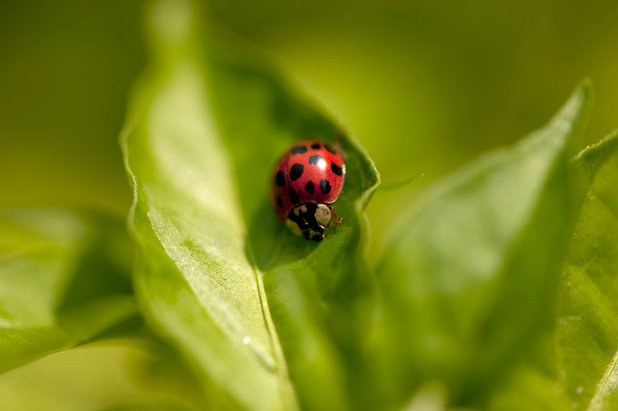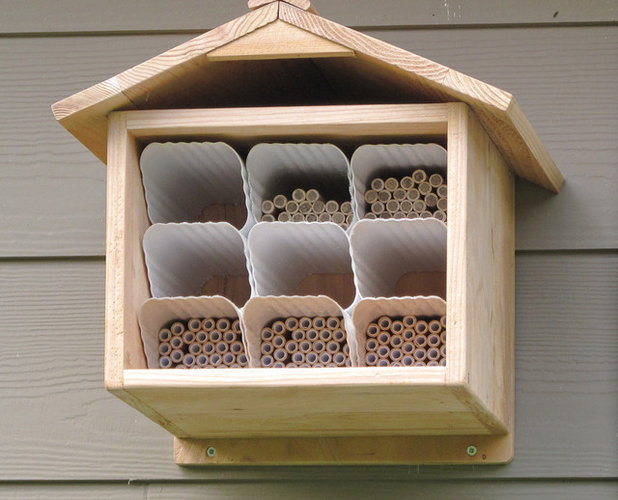Summer's long days and warm nights are perfect for going outside and enjoying your garden. Finally, all the work you've put in over the past year is paying off, and you can relax and enjoy the fruits of your labor. Unfortunately, you're probably not the only one who wants to enjoy your plot — there's a veritable legion of nasty critters waiting to spoil your outdoor plans and send you to the safety of your home.
Along with these unwelcome guests, however, there are a number of beneficial garden insects. But how do you get rid of the bad guys and welcome the good guys? With a little planning and old-school knowledge, you can accomplish this without pesticides or other chemicals that can harm you and your garden.
Here you'll learn some of the more common insect threats to your garden and how you can persuade the bad bugs to leave on their own volition.

Rossington Architecture
4 Garden Pests and How to Eliminate Them
Mosquitoes. In most areas mosquitoes are a major issue in the summertime and can hinder outdoor activities. They thrive in areas with a regular water supply and can multiply very quickly into large numbers if left unchecked. All of your garden's water features should have movement on the surface of the water. Mosquito larvae can survive only in stagnant water, so if a pump is installed in a water feature, mosquito colonies are less likely to survive. Introducing fish into a pond is also a great way to combat mosquitoes, since they eat the larvae before they hatch. Goldfish, minnows and betta fish (also called Siamese fighting fish) are all great options for controlling mosquitoes.
Finally, there are several plants you can add to your garden to help repel mosquitoes.
Catnip is a natural mosquito repellent that grows in most areas as an easy-growing perennial.
Marigolds also have a distinctive smell that is unbearable to mosquitoes. Try planting these annuals in pots around your patio and next to windows, and the smell will prevent mosquitoes from hanging around.

Kim Gamel
Wasps. As the summer winds on, wasps can become a major issue in the garden. These aggressive carnivores have ruined many an outdoor dinner. Unfortunately, vibrant-colored blooms can attract them, so put plants that bloom in the summer away from sitting and dining areas. You can also deter wasps by putting out a bowl of crushed cloves on the dining table — the smell is offensive to wasps, and they will find somewhere else to spend their time.
Ants. Depending on where you live, there are many types of ants that can make a home in your garden. Some ants are harder to get rid of than others. Thankfully, the ants in Vancouver, where I live, are relatively easy to control.
As a rule of thumb for all ants, focus on where they live and what they feed on to dissuade them from your garden. Ants don’t like the smell of cinnamon or mint, so if you are able to find the mound where the ants are coming from, sprinkle some cinnamon or move a potted mint plant to the area (mint should always be contained, as it is an aggressively invasive plant) to make the area less hospitable to these little pests.
But ants are tenacious critters, and they may just move their home elsewhere in your garden. That's why it’s also important to focus on their food source. One of the ways that ants gain sustenance is by “farming” the honeydew secreted from aphids. They will even go so far as to move the aphids onto prime real estate on fruit trees and develop elaborate systems for aphid farms to produce honeydew. And this leads us to our last pest:
Aphids. Aphids can be tricky to eradicate, and the solution usually comes down to a combination of tactics. I’ve found blasting them off plant leaves with the hose to be the most effective once they’ve infested a plant (versus soap-based sprays, which can often damage leaves), but there are also beneficial insects that can be introduced to your garden to deal with an aphid problem.

The New York Botanical Garden
2 Beneficial Garden Insects and How to Welcome Them
Ladybugs. As mentioned previously, aphids are a major issue in the garden. Ladybugs are a natural predator of aphids and can make a big difference to the health of your garden. An adult ladybug can eat up to 1,000 aphids a day, so it’s easy to see how introducing this little helper can be beneficial. You can buy ladybugs at many garden centers, but before you spend the money, make sure you take appropriate measures to help them stick around instead of flying off to your neighbor’s garden:
- Make sure that there is no insecticide on your plants, and inspect the leaves to see if there are aphids.
- Release the ladybugs at night (they do not fly at night, so they are more likely to get established in your garden immediately) near the aphid-affected plants.
- Provide food sources other than aphids to make them feel at home. Ladybugs also eat pollen and love many flowering plants, such as marigolds, fennel, dill and geraniums.

Le jardinet
Mason bees. Bees and wasps often get thrown in the same category of garden pests, but in reality, bees play an important role in the life cycle of plants. They also have more important things to focus on than you and your garden guests, so they aren’t likely to sting or be a nuisance. Bees are avid pollinators and a crucial component of food crop production. Global honeybee populations are in decline, so it's more important than ever to help other types of bees take hold of the pollination tasks at hand.
That’s where mason bees come in. Introducing mason bees into your plot is as easy as sourcing a mason bee house and some bee cocoons. Make sure there is also a water source available so that the bees can produce mud to pack their cocoons into the mason bee house.
The cocoons hold dormant mason bees that come to life when the temperature warms in the spring (optimal conditions are when the noontime temperature is a minimum of 57 degrees Fahrenheit or 14 degrees Celsius). They can be kept in the fridge until the time is right to release them. Mason bees do not form hives and live short lives. Given the right conditions (flowering plants, a water source and a home to lay eggs in), they will work hard to pollinate your plants throughout the summer, and the cocoons that are left behind in the mason bee house can be placed in containers in the fridge in the fall and saved until next spring.





